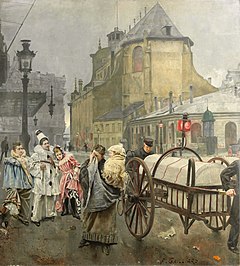Temple of the Augustinians, Brussels
The Temple of the Augustinians or Augustine Church (French: Temple des Augustins, alternatively Eglise des Augustins; Dutch: Augustijnenkerk) in Brussels was a baroque-style church designed by the architect Jacob Franquart for the Augustinians order in Brusssels. It was built from 1621 to 1642.[1] It was located on De Brouckère Square in the centre of Brussels until its demolition in 1893–1894.[2]
.jpg)
History
Closed by French revolutionary troops in 1796, the only remaining part of a convent, the church reopened for Roman Catholic worship in 1805. In the run-up to the Battle of Waterloo (1815), it served as an arsenal for British troops and subsequently as a military hospital.[3]
Under Dutch rule, the building was designated a Protestant place of worship, alongside the Brussels Protestant Church on Museum Square,[4] and the Dutch Church (Nederlandse gemeente) met in the Temple from 1816 until the Belgian revolution in 1830.[3] The first Reformed service was held on 1 September 1816 and Hermannus Pauw (born 1770) and Dirk Rijke (1789–1830) served as ministers from 1816–1830. In March 1817, the future King William III was baptised in the Temple. Anglican Reverend Holworthy, chaplain to the British Ambassador, held English-language services in the Temple until 1829.

The last Protestant service was held on 21 August 1830. From 5 September the building was occupied by Belgian patriots. Many of the worshippers fled the city and the Dutch Church was left without a building, meeting in various locations before it eventually built its own premises at Zuidkaai in 1857.[5]
After 1830 the Temple served various purposes: for performances,[6] exhibitions, and even as a post office. It survived the covering of the Senne river, a drastic destruction and renovation of downtown Brussels. At the centre of De Brouckère Square, the church’s facade was intended by architect Léon Suys to be one of the focal points of the new boulevards. The work to cover the river, which nearly surrounded the church, preserved the integrity of the building at great trouble and expense, but the church was finally demolished in 1893, its style no longer popular with the people and its presence unsuitable for the area. The church was replaced by a fountain-obelisk dedicated to the memory of Jules Anspach.
The Temple was demolished in 1893–1894. However the facade masonry was retained and was reconstructed as the facade of the Church of the Holy Trinity at Parvis de la Trinité in the suburban Ixelles district of Brussels.[1]
See also
- List of churches in Brussels
References
- http://www.irismonument.be/pdf_buildings.phpcity=1050&street=Parvis_de_la_Trinite&number=A001&lg=fr&lg=fr%5B%5D
- "Historic photo of the Temple, Archived copy". Archived from the original on 2011-07-27. Retrieved 2010-04-27.
- Theologienet
- l'église Protestante de Bruxelles
- http://www.protestantsekerkbrussel.com/Geschiedenis.htm
- http://www.brusselnieuws.be/artikels/stadsleven/verloren-verleden-de-brusselse-augustijnen/%5B%5D
External links
